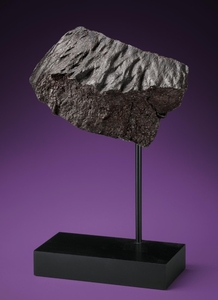Deep Impact: Martian, Lunar and other Rare Meteorites
This fine meteorite fragment was part of an oriented meteorite as indicated by elongated regmaglypts etched into its crust. The crust is a burnt umber with a light desert varnish; the exposed internal matrix exhibits variegated earth-hues. Accompanied by a custom armature.
69 x 112 x 51 mm. (2¾ x 4½ x 2 in.) and 629 g. (1⅓ lbs)
A superior example of an oriented meteorite. Unlike 99% of all meteorites, oriented meteorites don’t invert or tumble as they plunge through Earth’s atmosphere. This only occurs when there is a fortuitous distribution of the meteorite’s mass as well as a fortuitous angle of entry into the atmosphere. As a result of maintaining the same axis of orientation, such meteorites gain a wonderful aesthetic appearance and their direction of flight is readily discerned. The parabolic curve on the leading face of oriented meteorites is the angle at which heat is most efficiently deflected from a falling body — and this same curve inspired the design of the heat shields for NASA’s Mercury, Gemini and Apollo capsules. Meteorites possess highly specific elemental signatures, not only in regard to their constituent elements, but also the ratios of these elements. Based on the foregoing, XRF analysis, combined with the oriented nature of the specimen (unlike 99% of all meteorites, it did not tumble along its vertical axis while plunging through the atmosphere), it has been confirmed that this is a meteorite — and a superior example at that.
To enable scientists to refer to individual meteorites, there must be a nomenclature system in place. Meteorites are named after the localities where they fall, but in the desert, where there are few distinguishing geological features, meteorites are named after the designated grid in which they are found and are assigned sequential numbers. As the current offering was found in the Sahara Desert, it would be assigned a name that commences “Northwest Africa” (NWA) followed by a number.
For this specimen to become “named”, a 20-gram (or larger) sample must be sent to an accredited researcher for analysis. The researcher’s findings are then peer reviewed and upon a consensus of the specimen’s petrography, geochemistry, type and classification, the meteorite is then named and published in the Meteoritical Bulletin and is then part of the scientific literature. Should one wish to have this meteorite classified and be listed in the annals of the Meteoritical Bulletin — or one can remain anonymous if preferred — we can provide the introduction and guidance through this process.
Christie's would like to thank Dr. Alan E. Rubin at the Institute of Geophysics and Planetary Physics, University of California, Los Angeles for his assistance in preparing this catalog note.
View it on
Estimate
Time
Auction House
This fine meteorite fragment was part of an oriented meteorite as indicated by elongated regmaglypts etched into its crust. The crust is a burnt umber with a light desert varnish; the exposed internal matrix exhibits variegated earth-hues. Accompanied by a custom armature.
69 x 112 x 51 mm. (2¾ x 4½ x 2 in.) and 629 g. (1⅓ lbs)
A superior example of an oriented meteorite. Unlike 99% of all meteorites, oriented meteorites don’t invert or tumble as they plunge through Earth’s atmosphere. This only occurs when there is a fortuitous distribution of the meteorite’s mass as well as a fortuitous angle of entry into the atmosphere. As a result of maintaining the same axis of orientation, such meteorites gain a wonderful aesthetic appearance and their direction of flight is readily discerned. The parabolic curve on the leading face of oriented meteorites is the angle at which heat is most efficiently deflected from a falling body — and this same curve inspired the design of the heat shields for NASA’s Mercury, Gemini and Apollo capsules. Meteorites possess highly specific elemental signatures, not only in regard to their constituent elements, but also the ratios of these elements. Based on the foregoing, XRF analysis, combined with the oriented nature of the specimen (unlike 99% of all meteorites, it did not tumble along its vertical axis while plunging through the atmosphere), it has been confirmed that this is a meteorite — and a superior example at that.
To enable scientists to refer to individual meteorites, there must be a nomenclature system in place. Meteorites are named after the localities where they fall, but in the desert, where there are few distinguishing geological features, meteorites are named after the designated grid in which they are found and are assigned sequential numbers. As the current offering was found in the Sahara Desert, it would be assigned a name that commences “Northwest Africa” (NWA) followed by a number.
For this specimen to become “named”, a 20-gram (or larger) sample must be sent to an accredited researcher for analysis. The researcher’s findings are then peer reviewed and upon a consensus of the specimen’s petrography, geochemistry, type and classification, the meteorite is then named and published in the Meteoritical Bulletin and is then part of the scientific literature. Should one wish to have this meteorite classified and be listed in the annals of the Meteoritical Bulletin — or one can remain anonymous if preferred — we can provide the introduction and guidance through this process.
Christie's would like to thank Dr. Alan E. Rubin at the Institute of Geophysics and Planetary Physics, University of California, Los Angeles for his assistance in preparing this catalog note.



